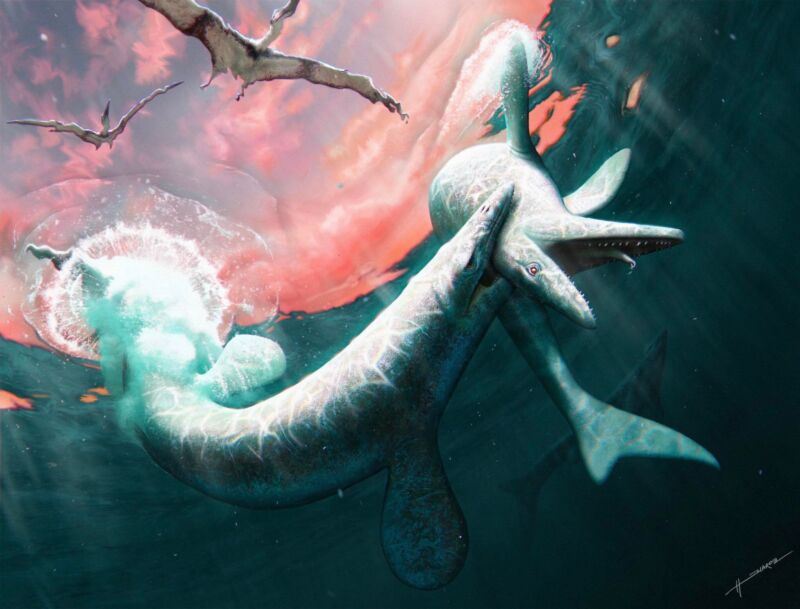
Henry Sharpe / AMNH
In 2015, Deborah Shepherd returned to the site where she and other volunteers had worked on a public fossil dig with family members. That’s when she saw it: a fossil lying there, exposed on the surface. Most people would not have recognized it for what it was: It wasn’t a skull, a leg bone, or even a partial jaw. It was just a chunk of bone.
Shepherd immediately notified a park ranger. That ranger then notified the North Dakota Department of Mineral Resources. Her actions ultimately led to the discovery of what scientists say is not only a new species, but an entirely new genus of mosasaur, a giant marine predator from Late Cretaceous seas. Bite marks preserved on the fossil also suggest that it met its end at the hands—or rather teeth—of another mosasaur.
Meet Jorgie the mosasaur
The new mosasaur was described Monday in the Bulletin of the American Museum of Natural History. Jǫrmungandr walhallaensis, or “Jorgie” for short, is the name suggested by co-author Clint Boyd, and it’s steeped in Norse mythology. Jǫrmungandr is the name of a sea serpent who circles the world with its body, clasping its tail in its jaws.
Walhallaensis references Walhalla, North Dakota—a town close to the fossil site where this mosasaur was excavated. Walhalla is a reference to the great hall Valhǫll (Valhalla), where Odin, the Norse god, resurrects dead soldiers to rise in combat for battles caused by Jǫrmungandr when it releases its tail (an event known as Ragnarǫk).
Mosasaurs were most decidedly non-mythical, however. They were enormous and toothy carnivores, some of which could reach lengths of approximately 15 meters (about 50 feet). Although entirely aquatic, they needed to surface to breathe air like today’s whales. The earliest forms had legs, indicating an ancient migration from land to sea. And while a substantial number of mosasaurs have been excavated throughout the world, we still have much to learn about these animals and their evolution.
What remains of Jorgie is an almost complete skull, some of its ribs, and a number of its vertebrae. Unlike most other mosasaurs, this one preserves the bones inside the skull that shaped the mouth and are rarely seen or found in other mosasaur specimens.
Bite marks on the bones indicate a violent struggle right before it died, leading to a potentially gruesome death. A few bite marks on the vertebrae show no signs of healing, which signals their occurrence close to, if not exactly, when Jorgie died approximately 80 million years ago.
Those marks are defined enough to determine the potential bite maker. The possible culprit? Another mosasaur. Worse, that specific set of bites may have led to the dismemberment of Jorgie, detaching one part of its body from the other. Because Jorgie’s skull has no bite marks, the team posits that its killer was eating the lower part of its body, a possible reason so little of its body has been found.
Found on the side of the road
What might have been an intensely dramatic scene millions of years ago is in stark contrast to the relatively mundane setting in which the bones were found. The site of the public fossil dig is in a spot adjacent to a gravel road in a North Dakota state park. Boyd is the senior paleontologist for the North Dakota Geological Survey and curator of the North Dakota State Fossil Collection. He is also part of the team that organizes and leads the public digs.
“The rock is really soft there,” Boyd explained in a video interview. “It weathers really quickly. And since it’s right next to a road, it’s cut very steeply and is unstable.” As the rock crumbles, this exposes new fossils. “That’s the whole reason there’s a public fossil dig to begin with: to save the fossils that are otherwise going to be lost to collapsing [rocks].”
But how do you go from finding a fossil to determining that it belongs to a new species and a new genus?
Lead author Amelia Zietlow, whose dissertation focuses on mosasaurs, is a PhD candidate at the Richard Gilder Graduate School at the American Museum of Natural History in New York. In a video interview, she mentioned that she has been asked which is most important in the decision to name a new species: its anatomy, or a fossil’s location in the sediment (the stratigraphy), which would indicate when the animal existed.
“It has to be anatomy,” Zietlow stated. “That is what taxonomy is. You’re describing the animal, and the animal is based on the anatomy. For determining what species something is, it doesn’t really matter when it lives or what the environment was like, although those are certainly important factors for other biological questions.”









